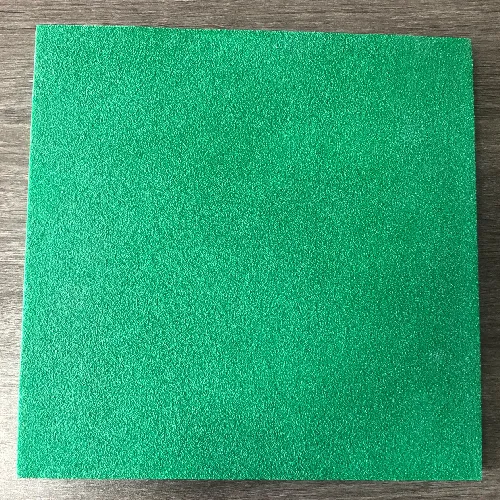loading...
- No. 9, Xingyuan South Street, Dongwaihuan Road, Zaoqiang County, Hengshui, Hebei, China
- admin@zjcomposites.com
- +86 15097380338
- Welcome to visit our website!
Effective Techniques for Cutting FRP Grating Materials with Precision and Safety
Understanding the Cutting of FRP Grating Techniques and Applications
Fiber Reinforced Plastic (FRP) grating has emerged as a highly effective material in various industrial applications due to its exceptional benefits such as corrosion resistance, lightweight properties, and high strength. However, to optimize its use, precise cutting techniques are essential. This article delves into the cutting of FRP grating, exploring its significance, techniques, and applications.
What is FRP Grating?
FRP grating is composed of a polymer matrix reinforced with fiberglass, which enhances its structural integrity. The material is designed to serve as a durable alternative to traditional grating materials such as steel and aluminum. Owing to its resistance to chemicals and environmental degradation, FRP grating is commonly utilized in industries like petrochemicals, water treatment, food processing, and pulp and paper manufacturing.
Importance of Cutting FRP Grating
The cutting of FRP grating is crucial for achieving custom sizes and shapes to fit specific installations. Accurate cutting ensures that the grating fits perfectly into the designated space, providing secure footing while minimizing the risk of accidents. Additionally, well-cut grating can improve the aesthetics of an installation, making it visually appealing without compromising safety and functionality.
Techniques for Cutting FRP Grating
1. Mechanical Cutting Mechanical cutting is one of the most common methods for cutting FRP grating. Tools like circular saws, band saws, or jigsaws fitted with appropriate blades can easily slice through this composite material. It is essential to use carbide-tipped blades to ensure clean cuts and prevent fraying of the fiberglass strands.
2. Diamond Saw Cutting For a more refined cut, employing a diamond saw can be advantageous. Diamond blades provide precision and minimize the chances of damage to the surrounding material. This method is particularly useful for intricate cutting patterns or reducing the risk of chipping.
cutting frp grating

3. Water Jet Cutting Water jet cutting is an advanced technique that uses high-pressure water to cut through FRP grating. This method avoids thermal damage and ensures that the material's integrity is maintained. Water jets can produce complex shapes and are particularly beneficial when working with thicker grating materials.
4. Laser Cutting Although less common, laser cutting is another effective method for shaping FRP grating. Utilizing laser technology allows for precise cuts with minimal kerf. This method is well-suited for high-volume production where accuracy is a priority.
Safety Considerations
When cutting FRP grating, safety should be a top priority. Operators must be equipped with appropriate personal protective equipment (PPE), including safety goggles, gloves, and masks, to prevent inhalation of fiberglass particles. Additionally, ensuring that the workspace is well-ventilated can mitigate health risks associated with cutting composite materials.
Applications of Cut FRP Grating
The versatility of cut FRP grating allows it to be employed in numerous applications. Custom-sized pieces of grating are commonly used for walkways, platforms, stair treads, and drainage covers in industrial settings. Its lightweight nature makes installation easier, while its slip-resistant surface enhances safety in high-traffic areas.
Furthermore, because of its corrosion resistance, FRP grating is particularly beneficial in chemical processing and marine environments. Facilities that handle harsh chemicals or are exposed to seawater can take advantage of FRP grating, reducing maintenance costs and enhancing longevity.
Conclusion
The cutting of FRP grating plays a pivotal role in maximizing its applicability across various industries. By employing the right techniques, users can ensure that FRP grating fits seamlessly into their desired installations, balancing safety, efficiency, and aesthetics. As industries continue to evolve, the demand for tailored solutions featuring high-performance materials like FRP will only grow, underpinning the importance of effective cutting methods in this field.
-
GRP Structures: The Future of Lightweight, High-Performance EngineeringNewsJun.20,2025
-
FRP Water Tank: High-Performance Storage for Corrosive and Clean Water SystemsNewsJun.20,2025
-
FRP Square Tube: The New Industry Standard for Chemical and Structural ApplicationsNewsJun.20,2025
-
FRP Pultruded Profiles: The Ultimate Choice for Lightweight Structural StrengthNewsJun.20,2025
-
FRP Handrails: The Safer, Smarter, and Stronger Choice for Modern InfrastructureNewsJun.20,2025
-
FRP Grating: The Smart Solution for Durable, Lightweight Industrial FlooringNewsJun.20,2025
-
Why Choose a Galvanized Water Tank for Your Storage NeedsNewsMay.21,2025
